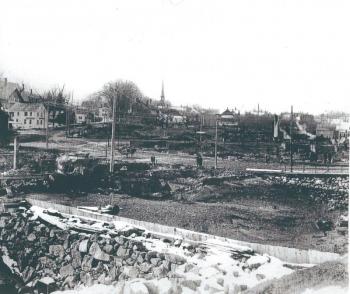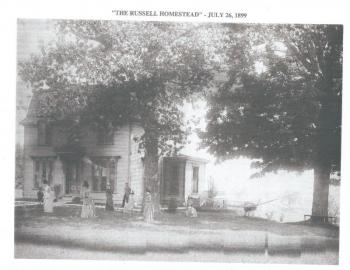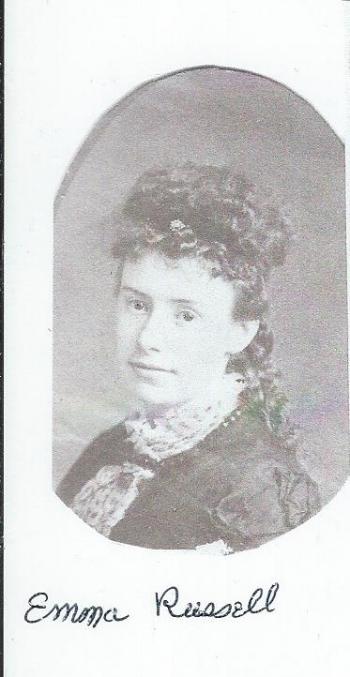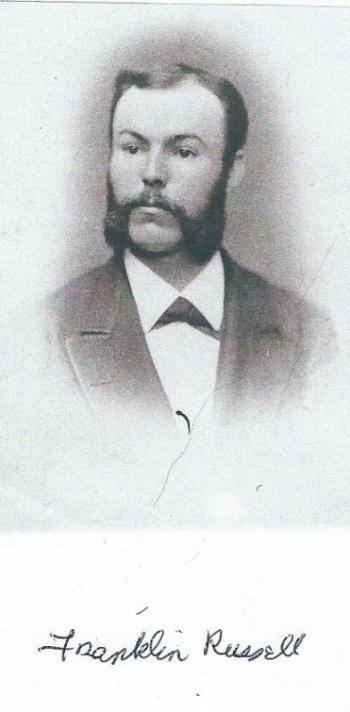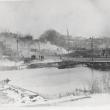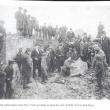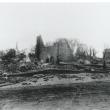Barbara F. Dyer: Up from the ashes
People have asked me, ”Do you always tell the truth, when writing your articles?” The answer is “Yes.” But this one is a true historical fiction, that I dreamed up when imagining about the Great Fire of Camden that happened in 1892. The characters are real people living then and the action taken.
Dexter Russell arrived home rather tired, but in good spirits. He had been at the Businessmen's Club, and the conversation had been almost entirely about the progress of Camden since the first settler, James Richards, had arrived 123 years before. Camden had grown to include about every business and profession needed, although they had separated from Rockport only the previous year.
Dexter's son, Russell, had become one of the businessmen on November 30, 1878, when he operated his Boston Store, where he sold dry goods. He had moved from the Alden block, on the East side of Main Street, right on the corner of the alley (known as Commercial Street today), that led down to the Anchor Factory. Within a couple of years, he moved to the so-called Masonic Block, because the rent was only $150 per year and he had been paying $175 to the Alden Block. A year later he was able to buy the Glover store for his business. Yes, things were going great.
FIRE
Dexter, being in his 65th year, and after a nice evening, decided to retire. He had been asleep only a short time, when the smell of smoke awakened him. It must be from the Camden Anchor Works. They worked night and day at that noisy, smoky industry, turning out all size anchors for ships sailing all over the world.
He rolled over in bed and tried to forget about the smoke. At about 1:30 a.m. the fire alarm sounded clearly in the cold air, bringing Dexter and many other Camden residents to their feet. He heard someone pounding on his door and yelling: ”Dexter, Dexter. Grab your pants and jacket because something is burning on Main Street.”
Excitedly he yelled back, ”I'm coming, Holly, the firemen are going to need some help, and I must check on Franklin's store!”
As they ran in the direction of the fire, a fierce easterly wind was blowing from the harbor and fanning the flames. Many people gathered there to watch the burning of the Cleveland Store, as the fire had started there in the basement heating system (Village Shop today). It was taking nearby buildings and then leaping over the street consuming everything in its path, north and south.
The fire department had arrived but the water pressure was inadequate and gave out. They did not have any equipment except hoses. The water came from watering troughs along the streets for horses. No one thought anything like that fire would happen. The flames crossed Mechanic Street burning stores on the north of Elm Street and Mechanic. It crossed Washington Street burning the Megunticook Hall. It then took Dr. Albee's home and partially consumed the home belonging to Dr. Tibbetts. On Washington Street, the Methodist Church and chapel were destroyed, but so was the Fire Station. Nearly every business block in town went up in flames. Forty or more buildings lay under snow in ruins; along with their contents, 60 businesses, 10 societies and 18 families were homeless.
The morning after
The whole town lay in ashes under a light blanket of snow. The Misses Carrie and Emma Russell managed Franklin's store and were reading the Camden Herald.
“It is unbelievable the fire did not make the front page of the paper,” Miss Emma said. “Oh, there is an editorial by Thaddus Simonton.” Miss Carrie asked,” What did it say?”
“It is very upbeat,” answered Emma. “I feel that the time is now to make improvements in the buildings and streets of Camden. It is important to put into effect broad and liberal policies not only to benefit the present generation, but generations of the future, regardless of the expense. It should become more attractive, and raise money for the purpose by bonds of the town, running long enough so that those who enjoy the new town in the future can help pay for it. The burden of taxation should not be heavy at four percent.” Both ladies said, ”That sounds reasonable.”
Meanwhile, Dexter was talking with fellow members of the Chestnut Street Baptist Church. Their church and the First Congregational Church had been spared. They were holding a community service the following Sunday evening, as an expression of sympathy for people suffering both mentally and financially from the fire. The service was conducted by Rev. Lewis D. Evans, who was an eloquent speaker and well loved by the community although he had been here but three years.
The Hon. Thaddeus Simonton was called to be the first speaker. Dexter and others listened attentively as he spoke with sincere emotion of the strange and wild scenes of the previous week. Simonton said that the businessmen had courage, cheerfulness and determination to rise from the ashes and make Camden more beautiful and prosperous than ever. The Hon. Reuel Robinson next addressed the mixed congregation, comparing the fire to other disasters and noting the event could be a blessing. They were all encouraged. The losses really reached everyone in town, one way or another.
Robinson felt that immediate action should be taken to reconstruct the streets and rebuild the village more substantially than ever. The Rev. F. M. Preble of the Baptist Church spoke of the great loss of the Methodist Society and expressed sympathy from the whole community.
The Rev. Phelan, Methodist minister spoke last, but very expressively of the exciting scenes and the heroic efforts of the brave firemen. He stated that his people would build another temple of worship more beautiful than the one that lay in ashes.
“The law and the gospel speak in unison.” Dexter and family went home feeling uplifted from the service.
Planning the future
After a week the shock of the disaster was nearly over. Franklin Russell met with businessmen, George Cleveland, Tom Hunt, Allen Spear, E. C. Fletcher, E. H. Young and others. Most had set out to retrieve their losses, and some had already formulated their future plans. They definitely wanted to build of brick, but winter was upon them. They started to move buildings to temporary locations until spring. Franklin' store was a real loss but within five days, he had reopened on Bay View Street. Three weeks later he moved into a basement on Main Street. What a strange sight to go out and look around town. There are several buildings in progress, some are appearing temporarily from one moved. Carleton, Norwood (now French and Brawn) have ordered lumber from Bangor and will begin a two-story building on the same site as before. Some people have taken their business home; some are on Commercial Street, Bay View Street and even in the Ocean House. The Post Office was moved temporarily to the Bay View House with Postmaster Singhi and Miss Fletcher working from 5 a. m. to 11 p.m. The Russell family found that the Selectmen would be meeting every Friday in the counting room of Rollins and Ogier. During the meeting of November 23, 1892, they decided on some important issues.
Article 2. Voted no permanent building exterior, which shall be wholly or partially of wood, be erected bounded northerly by Megunticook River, easterly by Main Street, southerly by Elm Street and westerly by Washington Street, nor on the southerly side of Elm Street east of where Lane Studio stands, nor on the westerly side of Washington Street between Elm and Mechanic, nor on either side of Chestnut Street 100 yards from Elm Street, nor on either side of Bay View Street 100 yards from Elm Street, nor on either side of Commercial Street.
Article 3.Voted that the following committee, without pay, will investigate and look into the question of extending, widening or changing the streets in the burned district, Johnson Knight, W. H. Pascal, W. R. Gill, B. C. Adams and Charles Murphy.
Article 4.Voted the following committee, without pay ascertain our standing in regard to water supply.
Some assessed the progress, which was stupendous. There were three two-story brick stores built at one time, and are really one block, by G. T. Hodgman, George Burd and Sylvester Arau. Across the street, where the Fletcher store was, now stood the handsomest two-story brick-block, furnished in a very expensive manner (now Boynton's).
Next to it was the brick three-story Masonic Block.
Next to that Franklin Russell's brick-block two-stories high.
The adjoining lot belonging to the Huse heirs had not been built.
Beyond this was the Adam's block on the corner and an ornament to the square. All of this in one year. Carleton, Norwood had a three-story brick-block.
Next above, the Curtis building had been replaced by a three-story brick-block. Dr. W. F. Bisbee's two-story brick and W. R. Gill had beside it a three-story brick-block. The last, on the corner of Washington Street and Elm was the four-story French block. Crossing Washington Street on Elm was the beautiful Opera House (that was disputed - some calling it a white elephant) but the building went up in spite of an injunction.
“Well, Holly, that is a beautiful Methodist Church that went up across the street from your house,” said Dexter. A sewer had been laid through the principal streets and brick sidewalks were being laid.
The men, almost in unison said, ”Do you suppose the people in Camden, in a 100 or later years, will appreciate what we have been through and left for their heritage?”
Barbara F. Dyer has lived in Camden all of her life, so far.
More Barbara Dyer
‘We are out today for old Camden High, let us boost her with a will’
The Camden Fire Department: Since 1847, ‘always ready’
When President Roosevelt took the train from Rockland to Washington, D.C.
Carlos Salzedos' harp colony in Camden
Buttoning up the harbor for winter
The day when Camden burned down, 40 buildings lay in ash
Old Glory, the flag’s storied history, and proper etiquette
The Seaside Mountains of Camden
The story of the Barbie D, a little tug that has worked Camden Harbor for 60-plus years
Postcards and the way we communicated 100 years ago
The Babbs: A family integral to Camden history
When Camden paid a fine for having no minister preaching in town
The demise of a Camden-built vessel
Camden’s wooden boat builders were perfectionists
Building wooden boats in Camden, many years ago
Socializing and such, before television
The first years of the Camden Snow Bowl
The many moods of Camden Harbor
Demise of the Camden steamboat wharf
Curtis Island Lighthouse - the sentinel of Camden Harbor


